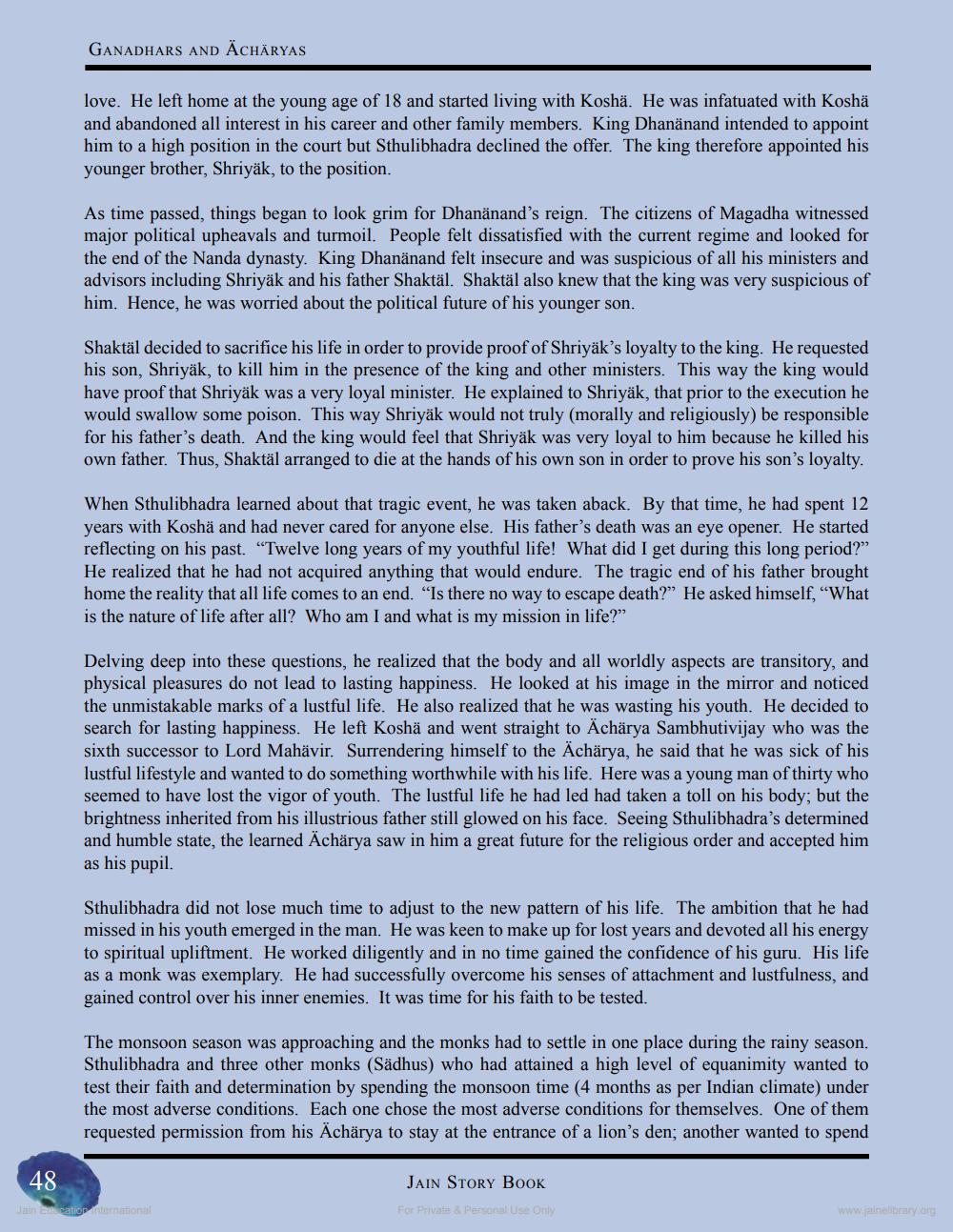________________
GANADHARS AND ACHARYAS
love. He left home at the young age of 18 and started living with Koshä. He was infatuated with Koshä and abandoned all interest in his career and other family members. King Dhanänand intended to appoint him to a high position in the court but Sthulibhadra declined the offer. The king therefore appointed his younger brother, Shriyak, to the position.
As time passed, things began to look grim for Dhanānand's reign. The citizens of Magadha witnessed major political upheavals and turmoil. People felt dissatisfied with the current regime and looked for the end of the Nanda dynasty. King Dhanänand felt insecure and was suspicious of all his ministers and advisors including Shriyäk and his father Shaktal. Shaktäl also knew that the king was very suspicious of him. Hence, he was worried about the political future of his younger son.
Shaktal decided to sacrifice his life in order to provide proof of Shriyäk's loyalty to the king. He requested his son, Shriyäk, to kill him in the presence of the king and other ministers. This way the king would have proof that Shriyak was a very loyal minister. He explained to Shriyak, that prior to the execution he would swallow some poison. This way Shriyäk would not truly (morally and religiously) be responsible for his father's death. And the king would feel that Shriyäk was very loyal to him because he killed his own father. Thus, Shaktäl arranged to die at the hands of his own son in order to prove his son's loyalty.
When Sthulibhadra learned about that tragic event, he was taken aback. By that time, he had spent 12 years with Koshä and had never cared for anyone else. His father's death was an eye opener. He started reflecting on his past. "Twelve long years of my youthful life! What did I get during this long period?" He realized that he had not acquired anything that would endure. The tragic end of his father brought home the reality that all life comes to an end. "Is there no way to escape death?" He asked himself, "What is the nature of life after all? Who am I and what is my mission in life?"
Delving deep into these questions, he realized that the body and all worldly aspects are transitory, and physical pleasures do not lead to lasting happiness. He looked at his image in the mirror and noticed the unmistakable marks of a lustful life. He also realized that he was wasting his youth. He decided to search for lasting happiness. He left Koshä and went straight to Ächärya Sambhutivijay who was the sixth successor to Lord Mahävir. Surrendering himself to the Ächärya, he said that he was sick of his lustful lifestyle and wanted to do something worthwhile with his life. Here was a young man of thirty who seemed to have lost the vigor of youth. The lustful life he had led had taken a toll on his body; but the brightness inherited from his illustrious father still glowed on his face. Seeing Sthulibhadra's determined and humble state, the learned Ächärya saw in him a great future for the religious order and accepted him as his pupil.
Sthulibhadra did not lose much time to adjust to the new pattern of his life. The ambition that he had missed in his youth emerged in the man. He was keen to make up for lost years and devoted all his energy to spiritual upliftment. He worked diligently and in no time gained the confidence of his guru. His life as a monk was exemplary. He had successfully overcome his senses of attachment and lustfulness, and gained control over his inner enemies. It was time for his faith to be tested.
The monsoon season was approaching and the monks had to settle in one place during the rainy season. Sthulibhadra and three other monks (Sädhus) who had attained a high level of equanimity wanted to test their faith and determination by spending the monsoon time (4 months as per Indian climate) under the most adverse conditions. Each one chose the most adverse conditions for themselves. One of them requested permission from his Acharya to stay at the entrance of a lion's den; another wanted to spend
48
Jain Exication international
JAIN STORY BOOK
For Private & Personal Use Only
www.jainelibrary.org




